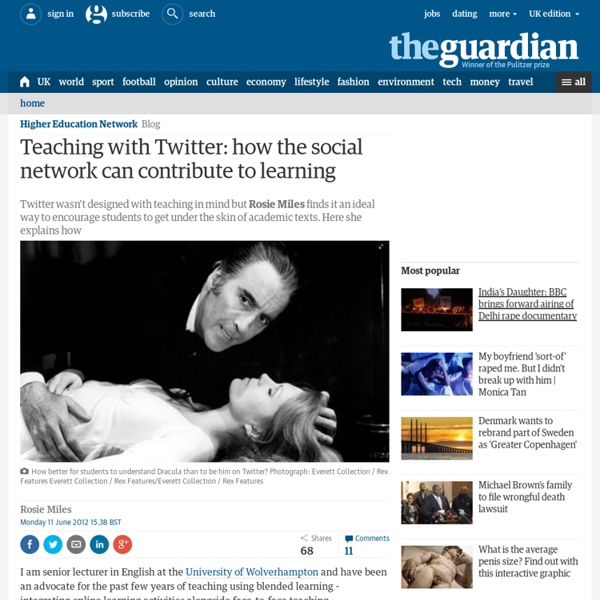Teaching with Twitter: how the social network can contribute to learning
I am senior lecturer in English at the University of Wolverhampton and have been an advocate for the past few years of teaching using blended learning - integrating online learning activities alongside face-to-face teaching. Two of my courses on Victorian literature feature a number of assessed online discussion forum activities. They get 100% participation - much of it enthusiastic. Online learning spaces are neutral - just like a 'real' classroom is. The important question to ask regarding e-learning is: What does an online space make possible by way of teaching that my class couldn't do face-to-face? I've only recently joined Twitter, but before I had a Twitter account I tried teaching with the spirit of Twitter. Dracula, who was already a tweeter in 'real life', immediately started 'hashtagging' - using a hashtag to mark keywords or topics and categorise tweets.
Is Donnie Darko human? | Human/Posthuman | The Posthuman
15/07/12 20:34 Filed in: Human/Posthuman A few questions for this week about Donnie Darko. Consider them all, then choose one or two to discuss in your response to this post. First:1. What happens to reality when it's put on film? What is the relationship between the reality we see in the world and the images we see on film? 2. Then, visit: 4. 5. Tags: Donnie Darko
Welcome to the English for Uni Website! | English for Uni
Welcome to the English for Uni website! This free website is for teachers and learners of English as an additional language, from intermediate levels upwards (i.e. approximately IELTS 6 and above). The site aims to make difficult grammar and academic writing concepts easier to understand. Please use this site as often as you like. You can also download all the explanations and exercises in pdf format. On this site you can learn more about: There is also information for speakers and learners of Japanese, Chinese, French and Indonesian. All the sections of this website have video stories, explanations and exercises. All the videos have captions that you can view on YouTube. You may also like to view the glossary of grammar terms and other useful websites for help.
Paul Nation - School of Linguistics and Applied Language Studies
BEdStud MA (Hons) DipTESL Paul Nation is Emeritus Professor in Applied Linguistics at the School of Linguistics and Applied Language Studies (LALS) at Victoria University of Wellington, New Zealand. His specialist interests are the teaching and learning of vocabulary and language teaching methodology. He has taught in Indonesia, Thailand, the United States, Finland and Japan. Recent books A recent book What you need to know to learn a foreign language pdf798KB is available to to dowload Translations pdf353KBSpanish - ¿Qué necesitas saber para aprender un idioma extranjero? The second edition of Learning Vocabulary in Another Language (2014) has now appeared from Cambridge University Press Two books written for teachers appeared in early 2013. The number of free Mid-frequency readers on this web site continues to increase (see below). A book, Making and Using Word Lists for Language Learning and Testing, has appeared in 2016 from John Benjamins. Publications Vocabulary Analysis programs Fiction
EAP Listening - Structure EAP Listening - Structure
Several studies (e.g. Chaudron & Richards, 1986; DeCarrico & Nattinger, 1988) have suggested that explicit signals of text structure are important in lecture comprehension. Listening for these signals can therefore help you understand the lecture. Signals The tables below show some of the most common signals used in lectures to indicate structure (Leech & Svartvik, 1975). 1. At the beginning of a lecture, or a section of a lecture, the lecturer will give you some idea about the structure of the lecture. 2. Before the new information is given, the lecturer will often summarise what you are expected to know about the subject to be covered. 3. In a lecture, it is often necessary to define the terms that will be used. 4. The lecturer will often be explicit about the order in which new points will be mentioned. 5. In lectures, it is common to make generalisations. 6. When you are taking notes, you cannot write down every word. 7. 8. 9. 10. 11. When we classify, we arrange members of a group.
Related:
Related:



